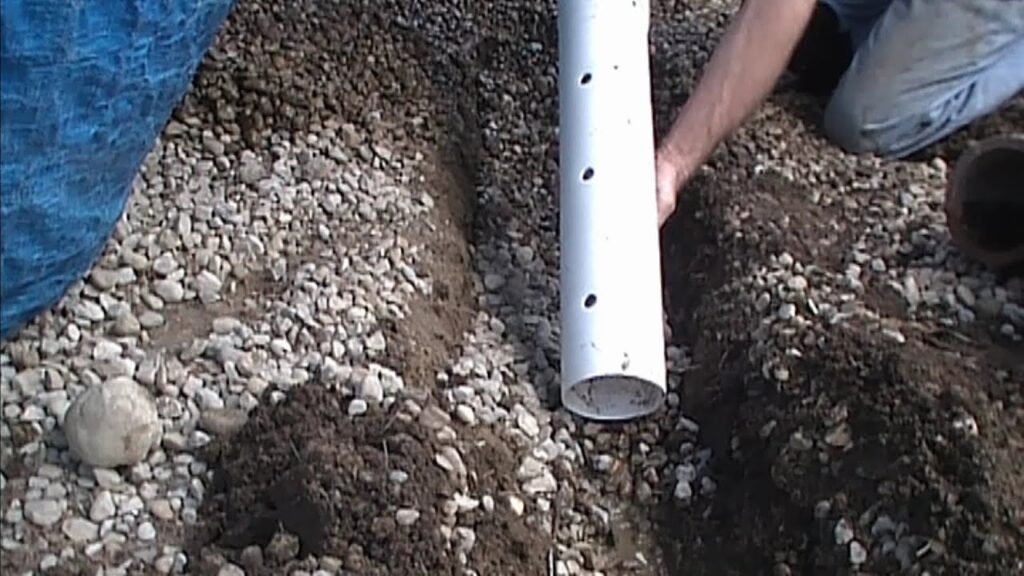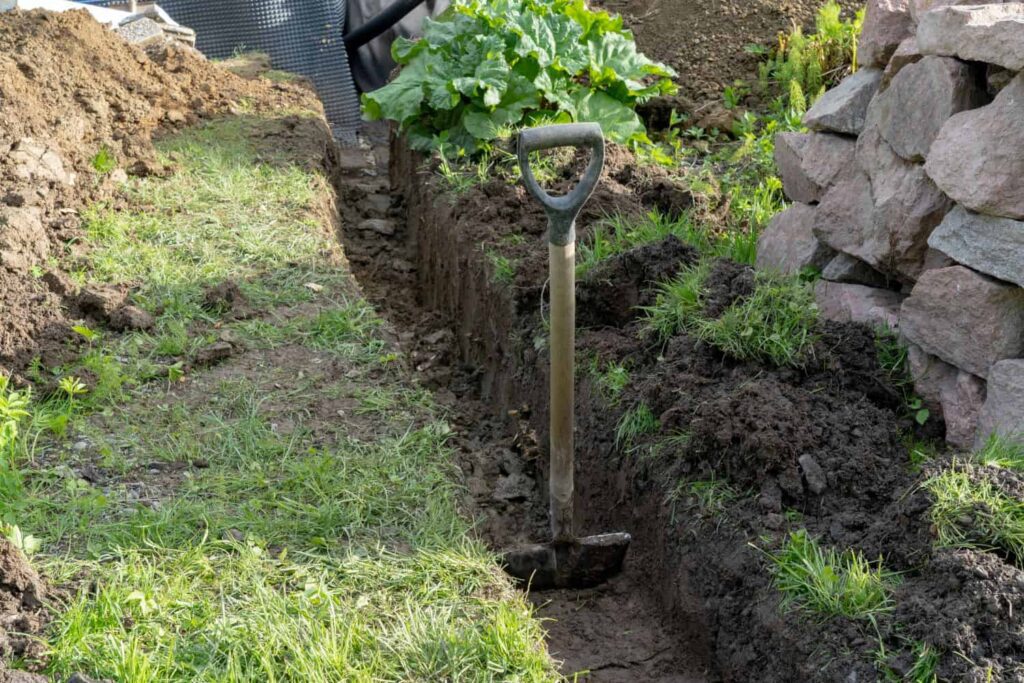How to Make a French Drain Without Pipe: Fast DIY Hack
You don’t need a pipe to create a working French drain. With the right gravel setup, you can manage runoff without the extra parts.
In this guide, we’ll show you how to make a no-pipe French drain that works—simple, cost-effective, and perfect for soggy spots in your yard.
How to Make a French Drain Without Pipe?
Dig a sloped trench and fill it with angular gravel—no pipe needed. It’s a simple, low-cost way to manage drainage in areas with light runoff.
Key Takeaways
- A no-pipe French drain uses only gravel to direct water away from problem areas.
- Ideal for light drainage in sandy or loamy soil.
- Requires a trench, a slope, and angular gravel—no pipe or fittings.
- Avoid mistakes like using pea gravel or skipping slope and filter fabric.
- Regular maintenance helps it last and perform effectively.
What Is a French Drain Without Pipe?

A no-pipe French drain is a simplified version of the traditional setup. It’s just a gravel-filled trench, without PVC or fabric-wrapped pipe.
It works because water naturally follows the path of least resistance. You dig the trench, slope it slightly, and let gravity do its thing.
This setup’s perfect if you want something simple, cheap, and easy to DIY. Just keep in mind—it drains slower than piped versions, so it’s more of a steady drip solution than a flash flood escape plan. Still, it gets the job done.
When Should You Use a French Drain Without Pipe?
Use a no-pipe French drain if your soil is sandy or loamy and water tends to pool lightly after rain.
It’s also solid for garden beds, side yards, or any spot where you don’t want to dig too deep or mess with fittings. Just gravel, a trench, and gravity doing its thing.
But if your soil’s heavy clay or you’re handling serious water, skip the shortcut. You’ll want a pipe for that kind of drama.
Tools and Materials You’ll Need
1. Shovel
You’re not digging a tunnel to Narnia, but you’ll still need a sturdy shovel. Go for one with a sharp edge to slice through turf and soil cleanly.
2. Wheelbarrow
Skip the back pain. A wheelbarrow makes hauling dirt and gravel way easier. Bonus points if it’s not wobbly like a shopping cart.
3. Landscape Fabric
This is your drain’s secret weapon. It keeps dirt out and lets water flow. No pipe? No problem—just wrap the gravel like a burrito.
4. Crushed Stone or Gravel
The real MVP here. Pick angular gravel so it stacks with gaps for water to move through. Rounded river rock? That’s a no from me.
Step-by-Step Guide to Making a French Drain Without Pipe
1. Mark the Drain Path
Pick where the water tends to gather. Use spray paint or a rope to mark a straight or curved line where the drain will go. Keep a slight slope—about 1 inch drop for every 8 feet is solid.
2. Dig the Trench
Grab a shovel and get moving. You want a trench around 12 inches wide, which is considered the best width for residential French drains, and 18–24 inches deep. Go deeper if the runoff is wild. Slope it gently from start to finish so gravity does its thing.
3. Line It Up (Optional but Smart)
Drop in some landscape fabric if you want to keep dirt from sneaking into the gravel. It’s like a filter that keeps things clean without clogging.
4. Add a Base Layer of Gravel
Pour in 3-4 inches of crushed rock or gravel. Not the shiny pea stuff—go with rough, angular stones. That shape locks in place and lets water flow through without getting blocked.
5. Fill the Trench with More Gravel
Now, fill the rest of the trench with more of that angular gravel. Stop about 2-3 inches below ground level. No pipe needed. This setup acts like a sponge and keeps things flowing underground.
6. Wrap It Up (Optional)
If you used fabric earlier, fold it over the top of the gravel. This just helps it last longer. If not, skip it. Totally fine either way.
7. Top It Off
Toss on some soil and grass seed if you want it to blend in. Or go full low-maintenance and add decorative rocks or mulch. Either way, it won’t look like a construction site.
Done right, this no-pipe French drain is a cheat code for backyard drainage. Cheap, low-key, and it works.
Maintenance Tips for Pipe-Free French Drains

1. Keep an eye out after storms
Heavy rain can shift gravel or clog up the surface. After a downpour, do a quick walkaround to check for puddles or backed-up flow.
2. Clear debris like it’s spring cleaning
Leaves, twigs, and dirt can block water movement. Use a rake or your hands to brush off the top every couple weeks.
3. Top up the gravel if it sinks
Over time, the fill can settle or wash away. Toss in fresh gravel when things start looking low—it’s an easy fix that keeps it flowing. While you’re at it, don’t forget to clean the grease trap under the sink regularly to prevent clogs and maintain proper drainage. A little maintenance goes a long way.
Common Mistakes to Avoid
1. Skipping the Slope
No slope? No flow. Water needs a path to follow. Aim for a slight downward angle or you’re just building a puddle pit.
2. Using the Wrong Gravel
Pea gravel might look clean, but it’s not the move. Go for angular gravel that locks together and keeps water moving, not lounging.
3. Skipping a Filter Fabric
Don’t let your hard work clog up. Wrap your trench with landscape fabric so soil doesn’t sneak in and ruin the flow.
4. Ending It Anywhere
Water needs an exit plan. Dumping it next to your house or your neighbor’s fence? Not cool. Use a dry well, pop-up emitter, or safe runoff zone.
Frequently Asked Questions
1. Can I build a French drain without a pipe?
Yes. Dig a trench, line it with fabric, and fill it with angular gravel. No pipe needed.
2. Will it actually drain water well?
If you use a good slope and proper materials, yes. It drains slowly and steadily.
3. How deep should the trench be?
About 18 to 24 inches works for most setups. Too shallow and water won’t move. Too deep? You’re just flexing your shovel game.
Conclusion
No pipe? No problem. You just built a low-key genius solution that still gets the job done. Gravel, slope, and a smart exit plan—that’s the trio.
Now, don’t forget the basics. Keep debris out, check for clogs after storms, and don’t skip that proper drain endpoint.
Whether you’re rocking a pop-up emitter or letting it run wild into a dry well, how you end it matters. Do it right, and water won’t stand a chance.
